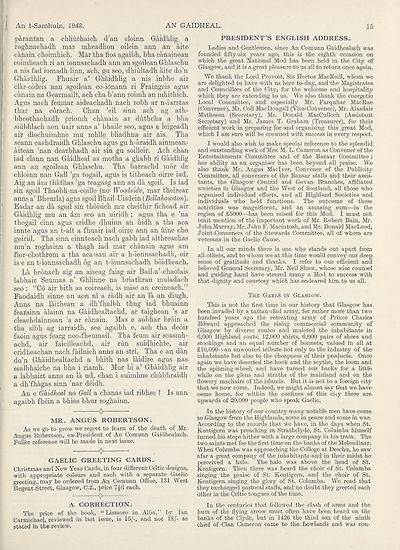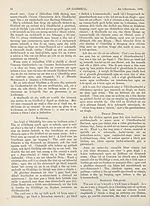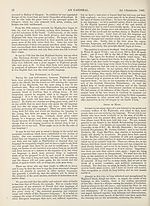An Comunn Gàidhealach Publications > Gaidheal > Volume 43, October 1947--December 1948
(171) Page 15
Download files
Complete book:
Individual page:
Thumbnail gallery: Grid view | List view

AN GAIDHEAL.
15
j An t-Samhuin, 1948.
parantan a chliuthaich d’an cloinn Gaidklig a
roghnachadh mar mheadhon oilein ann an aite
canain choimhicli. Mar tha fios agaibh, bha canainean
li coimheach ri an ionnsachadb ann an sgoilean Ghlaschu
a nis fad iomadh linn, acb, gu seo, dhiultadh aite do’n
Ghaidhlig. Fhuair a’ Ghaidblig a nis inbbe air
■ clar-oideis nan sgoilean co-ionann ri Fraingeis agus
canain na Gearmailt, acb cha b’ann roimb an mbitbicb.
Agus nacb feumar aideacbadb nach robb ar n-iarrtas
tbar na coracb. Cban ’eil sinn acb ag atb-
bbeotbacbadb priomb cbanain ar dutbcba a bba
siubblach aon uair anns a’ bbaile seo, agus a leigeadb
air dlocbuimbne mu mblle bliadbna air ais. Tba
seann eacbdraidb Gblascbu agus gu b-araidb ainmean-
aitean ’nan dearbbadb air sin gu soilleir. Acb cban
iad clann nan Gaidbeal as motba a gbabb ri Gaidblig
ann an sgoilean Gblascbu. Tba barracbd mor de
cbloinn nan Gall ’ga togail, agus is titbeacb oirre iad.
Aig an am tbatbas ’ga teagasg ann an da sgoil. Is iad
sin sgoil Tbaobb-na-coille (no Woodside, mar tbeirear
anns a’ Bbeurla) agus sgoil Bbail-Uisdein (Bellahouston).
Eadar an da sgoil sin tboisicb mu cbeitbir ficbead air
Gaidblig mu an am seo an uiridb; agus tba e ’na
tbogail cinn agus cridbe dbuinn an uidb a tba aca
innte agus an t-alt a fbuair iad oirre ann an uine cbo
goirid. Tba sinn cinnteacb nacb gabb iad aitbreacbas
mu’n rogbainn a tbagb iad mar cbanain agus am
flor-cbothrom a tba aca-san air a b-ionnsacbadh, oir
is e an t-ionnsacbadb 6g an t-ionnsacbadb boidbeacb.
La bronach aig an aiseag faisg air Bail-a’-cbaolais
labbair Seumas a’ Gblinne na briatbran muladacb
seo : “Co air bitb as coireacb, is mise an creineacb.”
Faodaidb sinne an aon ni a radb air an la an diugb.
Anns na laitbean a db’fbalbb tbug iad bbuainn
fearainn alainn na Gaidbealtacbd, ar taigbean ’s ar
cleacbdainnean ’s ar canain. Mas e aobbar broin a
tba sibb ag iarraidh, seo agaibb e, acb tba deoir
faoin agus fearg neo-fbeumail. Tba feum air seasmb-
acbd, air faicilleacbd, air run suidbicbte, air
cridbeacban nacb failnicb anns an strl. Tba e an dan
do’n Gbaidbealtacbd a bbitb nas laidire agus nas
sealbbaicbe na bba i riamb. Mur bi a’ Gbaidblig air
a labbairt arms an la ud, cban i cuimbne cbubbraidb
a db’fbagas sinn ’nar deidb.
An e Gdidheal no Gall a cbanas iad ribbse ? Is ann
agaibb fbein a bbios bbur rogbainn.
<>
MR. ANGUS ROBERTSON.
As we go to press we regret to learn of tlie death of Mr.
Angus Robertson, ex-President of An Comunn Gaidhealach.
Fuller reference will be made in next issue.
GAELIC GREETING CARDS.
Christmas and New Year Cards, in four different Celtic designs,
with appropriate colours and each with a separate Gaelic
greeting, may be ordered from An Comunn Office, 131 West
Regent Street, Glasgow, C.2., price 7£d each.
0
A CORRECTION.
The price of the book, “Lismore in Alba,” by Ian
Carmichael, reviewed in last issue, is 15/-, and not 18/- as
stated in the review.
PRESIDENT’S ENGLISH ADDRESS.
Ladies and Gentlemen, since An Comunn Gaidhealach was
founded fifty-six years ago, this is the eighth occasion on
which the great National Mod has been held in the City of
Glasgow, and it is a great pleasure to us all to return once again.
We thank the Lord Provost, Sir Hector MacNeill, whom we
are delighted to have with us here to-day, and the Magistrates
and Councillors of the City, for the welcome and hospitality
which they are extending to us. We also thank the energetic
Local Committee, and especially Mr. Farquhar MacRae
(Convener), Mr. Coll MacDougall (Vice-Convener), Mr. Alasdair
Matheson (Secretary), Mr. Donald MacCulloch (Assistant
Secretary) and Mr. James T. Graham (Treasurer), for their
efficient work in preparing for and organising this great Mod,
which I am sure will be crowned with success in every respect.
I would also wish to make special reference to the splendid
and outstanding work of Mrs. M. L. Cameron as Convener of the
Entertainments Committee and of the Bazaar Committee;
her ability as an organiser has been beyond all praise. We
also thank Mr. Angus Maclver, Convener of the Publicity
Committee, all conveners of the Bazaar stalls and their assis¬
tants, the Glasgow Central and Govan Branches, affiliated
societies in Glasgow and the West of Scotland, all those who
organised individual efforts, and all Highland Societies and
individuals who held functions. The outcome of these
activities was magnificent, and an amazing sum—in the
region of £5000—has been raised for this Mod. I must not
omit mention of the important work of Mr. Robert Bain, Mr.
John Murray, Mr. John F. Macintosh, and Mr. Donald MacLeod,
Joint-Conveners of the Stewards Committee, all of whom are
veterans in the Gaelic Cause.
In all our minds there is one who stands out apart from
all others, and to whom we at this time would convey our deep
sense of gratitude and thanks. I refer to our efficient and
beloved General Secretary, Mr. Neil Shaw, whose wise counsel
and guiding hand have steered many a Mod to success with
that dignity and courtesy which has endeared him to us all.
The Gaels in Glasgow.
This is not the first time in our history that Glasgow has
been invaded by a tartan-clad army, for rather more than two
hundred years ago the retreating army of Prince Charles
Edward approached the rising commercial community of
Glasgow by diverse routes and mulcted the inhabitants in
6,000 Highland coats, 12,000 shirts, 6,000 pairs of shoes and
stockings and an equal number of bonnets, valued in all at
£10,000—an unwonted tribute not only to the industry of the
inhabitants but also to the cheapness of their products. Once
again we have deserted the hook and the scythe, the loom and
the spinning-wheel, and have turned our backs for a little
while on the glens and straths of the mainland and on the
flowery machairs of the islands. But it is not to a foreign city
that we now come. Indeed, we might almost say that we have
come home, for within the confines of this chy there are
upwards of 20,000 people who speak Gaelic.
In the history of our country many notable men have come
to Glasgow from the Highlands, some in peace and some in war.
According to the records that we have, in the days when St.
Kentigem was preaching in Strathclyde, St. Columba himself
turned his steps hither with a large company in his train. The
two saints met for the first time on the banks of the Molendinar.
When Columba was approaching the College at Deschu, he saw
afar a great company of the inhabitants and in their midst he
perceived a halo. The halo was above the head of St.
Kentigern. Then there was heard the choir of St. Columba
singing the praise of St. Kentigern, and the choir of St.
Kentigem singing the glory of St. Columba. We read that
they exchanged pastoral staffs, and no doubt they greeted each
other in the Celtic tongues of the time.
In the centuries that followed the clash of arms and the
hum of the flying arrow must often have been heard on the
banks of the Clyde, but in 1426 the third son of the ninth
chief of Clan Cameron came to the Lowlands and was con-
15
j An t-Samhuin, 1948.
parantan a chliuthaich d’an cloinn Gaidklig a
roghnachadh mar mheadhon oilein ann an aite
canain choimhicli. Mar tha fios agaibh, bha canainean
li coimheach ri an ionnsachadb ann an sgoilean Ghlaschu
a nis fad iomadh linn, acb, gu seo, dhiultadh aite do’n
Ghaidhlig. Fhuair a’ Ghaidblig a nis inbbe air
■ clar-oideis nan sgoilean co-ionann ri Fraingeis agus
canain na Gearmailt, acb cha b’ann roimb an mbitbicb.
Agus nacb feumar aideacbadb nach robb ar n-iarrtas
tbar na coracb. Cban ’eil sinn acb ag atb-
bbeotbacbadb priomb cbanain ar dutbcba a bba
siubblach aon uair anns a’ bbaile seo, agus a leigeadb
air dlocbuimbne mu mblle bliadbna air ais. Tba
seann eacbdraidb Gblascbu agus gu b-araidb ainmean-
aitean ’nan dearbbadb air sin gu soilleir. Acb cban
iad clann nan Gaidbeal as motba a gbabb ri Gaidblig
ann an sgoilean Gblascbu. Tba barracbd mor de
cbloinn nan Gall ’ga togail, agus is titbeacb oirre iad.
Aig an am tbatbas ’ga teagasg ann an da sgoil. Is iad
sin sgoil Tbaobb-na-coille (no Woodside, mar tbeirear
anns a’ Bbeurla) agus sgoil Bbail-Uisdein (Bellahouston).
Eadar an da sgoil sin tboisicb mu cbeitbir ficbead air
Gaidblig mu an am seo an uiridb; agus tba e ’na
tbogail cinn agus cridbe dbuinn an uidb a tba aca
innte agus an t-alt a fbuair iad oirre ann an uine cbo
goirid. Tba sinn cinnteacb nacb gabb iad aitbreacbas
mu’n rogbainn a tbagb iad mar cbanain agus am
flor-cbothrom a tba aca-san air a b-ionnsacbadh, oir
is e an t-ionnsacbadb 6g an t-ionnsacbadb boidbeacb.
La bronach aig an aiseag faisg air Bail-a’-cbaolais
labbair Seumas a’ Gblinne na briatbran muladacb
seo : “Co air bitb as coireacb, is mise an creineacb.”
Faodaidb sinne an aon ni a radb air an la an diugb.
Anns na laitbean a db’fbalbb tbug iad bbuainn
fearainn alainn na Gaidbealtacbd, ar taigbean ’s ar
cleacbdainnean ’s ar canain. Mas e aobbar broin a
tba sibb ag iarraidh, seo agaibb e, acb tba deoir
faoin agus fearg neo-fbeumail. Tba feum air seasmb-
acbd, air faicilleacbd, air run suidbicbte, air
cridbeacban nacb failnicb anns an strl. Tba e an dan
do’n Gbaidbealtacbd a bbitb nas laidire agus nas
sealbbaicbe na bba i riamb. Mur bi a’ Gbaidblig air
a labbairt arms an la ud, cban i cuimbne cbubbraidb
a db’fbagas sinn ’nar deidb.
An e Gdidheal no Gall a cbanas iad ribbse ? Is ann
agaibb fbein a bbios bbur rogbainn.
<>
MR. ANGUS ROBERTSON.
As we go to press we regret to learn of tlie death of Mr.
Angus Robertson, ex-President of An Comunn Gaidhealach.
Fuller reference will be made in next issue.
GAELIC GREETING CARDS.
Christmas and New Year Cards, in four different Celtic designs,
with appropriate colours and each with a separate Gaelic
greeting, may be ordered from An Comunn Office, 131 West
Regent Street, Glasgow, C.2., price 7£d each.
0
A CORRECTION.
The price of the book, “Lismore in Alba,” by Ian
Carmichael, reviewed in last issue, is 15/-, and not 18/- as
stated in the review.
PRESIDENT’S ENGLISH ADDRESS.
Ladies and Gentlemen, since An Comunn Gaidhealach was
founded fifty-six years ago, this is the eighth occasion on
which the great National Mod has been held in the City of
Glasgow, and it is a great pleasure to us all to return once again.
We thank the Lord Provost, Sir Hector MacNeill, whom we
are delighted to have with us here to-day, and the Magistrates
and Councillors of the City, for the welcome and hospitality
which they are extending to us. We also thank the energetic
Local Committee, and especially Mr. Farquhar MacRae
(Convener), Mr. Coll MacDougall (Vice-Convener), Mr. Alasdair
Matheson (Secretary), Mr. Donald MacCulloch (Assistant
Secretary) and Mr. James T. Graham (Treasurer), for their
efficient work in preparing for and organising this great Mod,
which I am sure will be crowned with success in every respect.
I would also wish to make special reference to the splendid
and outstanding work of Mrs. M. L. Cameron as Convener of the
Entertainments Committee and of the Bazaar Committee;
her ability as an organiser has been beyond all praise. We
also thank Mr. Angus Maclver, Convener of the Publicity
Committee, all conveners of the Bazaar stalls and their assis¬
tants, the Glasgow Central and Govan Branches, affiliated
societies in Glasgow and the West of Scotland, all those who
organised individual efforts, and all Highland Societies and
individuals who held functions. The outcome of these
activities was magnificent, and an amazing sum—in the
region of £5000—has been raised for this Mod. I must not
omit mention of the important work of Mr. Robert Bain, Mr.
John Murray, Mr. John F. Macintosh, and Mr. Donald MacLeod,
Joint-Conveners of the Stewards Committee, all of whom are
veterans in the Gaelic Cause.
In all our minds there is one who stands out apart from
all others, and to whom we at this time would convey our deep
sense of gratitude and thanks. I refer to our efficient and
beloved General Secretary, Mr. Neil Shaw, whose wise counsel
and guiding hand have steered many a Mod to success with
that dignity and courtesy which has endeared him to us all.
The Gaels in Glasgow.
This is not the first time in our history that Glasgow has
been invaded by a tartan-clad army, for rather more than two
hundred years ago the retreating army of Prince Charles
Edward approached the rising commercial community of
Glasgow by diverse routes and mulcted the inhabitants in
6,000 Highland coats, 12,000 shirts, 6,000 pairs of shoes and
stockings and an equal number of bonnets, valued in all at
£10,000—an unwonted tribute not only to the industry of the
inhabitants but also to the cheapness of their products. Once
again we have deserted the hook and the scythe, the loom and
the spinning-wheel, and have turned our backs for a little
while on the glens and straths of the mainland and on the
flowery machairs of the islands. But it is not to a foreign city
that we now come. Indeed, we might almost say that we have
come home, for within the confines of this chy there are
upwards of 20,000 people who speak Gaelic.
In the history of our country many notable men have come
to Glasgow from the Highlands, some in peace and some in war.
According to the records that we have, in the days when St.
Kentigem was preaching in Strathclyde, St. Columba himself
turned his steps hither with a large company in his train. The
two saints met for the first time on the banks of the Molendinar.
When Columba was approaching the College at Deschu, he saw
afar a great company of the inhabitants and in their midst he
perceived a halo. The halo was above the head of St.
Kentigern. Then there was heard the choir of St. Columba
singing the praise of St. Kentigern, and the choir of St.
Kentigem singing the glory of St. Columba. We read that
they exchanged pastoral staffs, and no doubt they greeted each
other in the Celtic tongues of the time.
In the centuries that followed the clash of arms and the
hum of the flying arrow must often have been heard on the
banks of the Clyde, but in 1426 the third son of the ninth
chief of Clan Cameron came to the Lowlands and was con-
Set display mode to:
![]() Universal Viewer |
Universal Viewer | ![]() Mirador |
Large image | Transcription
Mirador |
Large image | Transcription
| An Comunn Gàidhealach > An Comunn Gàidhealach Publications > Gaidheal > Volume 43, October 1947--December 1948 > (171) Page 15 |
|---|
| Permanent URL | https://digital.nls.uk/125253324 |
|---|
| Description | This contains items published by An Comunn, which are not specifically Mòd-related. It includes journals, annual reports and corporate documents, policy statements, educational resources and published plays and literature. It is arranged alphabetically by title. |
|---|
| Description | A collection of over 400 items published by An Comunn Gàidhealach, the organisation which promotes Gaelic language and culture and organises the Royal National Mòd. Dating from 1891 up to the present day, the collection includes journals and newspapers, annual reports, educational materials, national Mòd programmes, published Mòd literature and music. |
|---|---|
| Additional NLS resources: |
|

